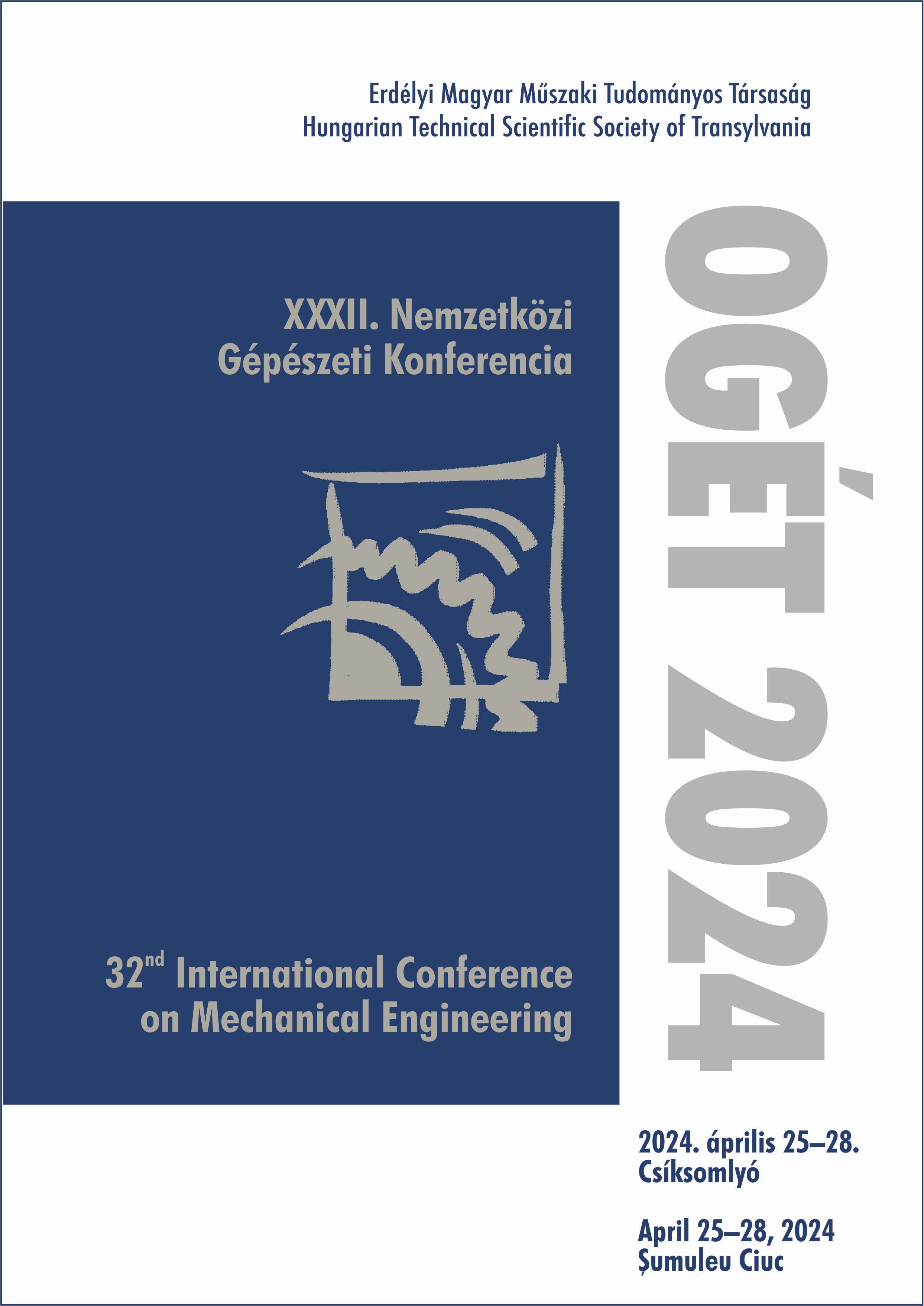A mesterséges intelligencia módszereinek helye a szimuláció alapú mérnöki optimalizálási feladatok megoldásában
The application of artificial intelligence techniques to simulation-based engineering optimization tasks
Keywords:
artificial intelligence, numeric simulation, engineering optimization, metaheuristic search algorithms, surrogate model, /, mesterséges intelligencia, numerikus szimuláció, mérnöki optimalizáció, metaheurisztikus, kereső eljárások, helyettesítő modellAbstract
Using an optimization process in place of a trial-and-error-based mechanical engineering design method can help a company stay competitive in the market if the iteration process can be automated. Numerical simulation software makes it possible to do this iteration process even before the product is manufactured, which saves a significant amount of money and time. This article aims to outline the potential applications of artificial intelligence tools for simulation-based engineering optimization tasks which is a further automation option that boosts innovation and the design cycle.
Kivonat
Ha lehetőség van az iterációs folyamat automatizálására, a próbálgatáson „what if” alapuló gépészeti tervezési módszer helyett, optimalizáló eljárás implementálásával lehet versenyképes maradni a piacon. A numerikus szimulációs eljárásoknak köszönhetően ezt az iterációs folyamatot már a késztermék legyártása előtt el lehet végezni, így jelentős időt, költséget és mérnöki munkaórát megtakarítva. Jelen cikk célja a szimuláció alapú mérnöki optimalizálási feladatokra ismertetni, a mesterséges intelligencia eszközeinek integrálási lehetőségeit. Az így adódó további automatizálási lehetőség felgyorsítja a tervezési ciklust és növeli az innovációt.
References
P. Norvig and S. J. Russell, Mesterséges intelligencia modern megközelítésben, 2nd ed. Budapest, HU: Panem Kiadó Kft., 2005.
B. Chopard and M. Tomassini, An Introduction to Metaheuristics for Optimization. Cham: Springer International Publishing, 2018. doi: 10.1007/978-3-319-93073-2.
A. Burkov, The Hundred-Page Machine Learning Book. 2019.
M. Kubat, An Introduction to Machine Learning. Cham: Springer International Publishing, 2017. doi: 10.1007/978-3-319-63913-0.
David E. Goldberg, Genetic Algorithms in Search, Optimization and Machine Learning. Boston, MA, USA: Addison-Wesley Longman Publishing Co., Inc., 1989.
S. Das and P. N. Suganthan, “Differential Evolution: A Survey of the State-of-the-Art,” IEEE Trans. Evol. Comput., vol. 15, no. 1, pp. 4–31, Feb. 2011, doi: 10.1109/TEVC.2010.2059031.
S. Kirkpatrick, C. D. Gelatt, and M. P. Vecchi, “Optimization by Simulated Annealing,” Science (80-. )., vol. 220, no. 4598, pp. 671–680, May 1983, doi: 10.1126/science.220.4598.671.
H. Drucker•, C. J. C. Burges, L. Kaufman, A. Smola••, and V. Vapoik, “Support Vector Regression Machines,” in Advances in neural information processing systems, 1997, pp. 155–161. Accessed: Feb. 15, 2020. [Online]. Available: https://papers.nips.cc/paper/1238-support-vector-regression-machines
R. E. Neapolitan and X. Jiang, “Neural Networks and Deep Learning,” in Artificial Intelligence, Chapman and Hall/CRC, 2018, pp. 389–411. doi: 10.1201/b22400-15.
S. Skansi, Introduction to Deep Learning. Cham: Springer International Publishing, 2018. doi: 10.1007/978-3-319-73004-2.
T. Kotsiopoulos, P. Sarigiannidis, D. Ioannidis, and D. Tzovaras, “Machine Learning and Deep Learning in smart manufacturing: The Smart Grid paradigm,” Comput. Sci. Rev., vol. 40, p. 100341, May 2021, doi: 10.1016/j.cosrev.2020.100341.
S. Khan and T. Yairi, “A review on the application of deep learning in system health management,” Mech. Syst. Signal Process., vol. 107, pp. 241–265, Jul. 2018, doi: 10.1016/j.ymssp.2017.11.024.
C. Erdősné Sélley, G. Gyurecz, J. Janik, and G. Körtélyesi, Mérnöki Optimalizáció. Budapest, HU: Typotex Kiadó, 2012.
P. Y. Papalambros and D. J. Wilde, Principles of Optimal Design. Cambridge: Cambridge University Press, 2017. doi: 10.1017/9781316451038.
M. J. K. T. A. Wheeler, Algorithms for Optimization. The MIT Press, 2019.
A. I. J. Forrester, A. Sóbester, and A. J. Keane, Engineering Design via Surrogate Modelling. Oxford, UK: Wiley, 2008. doi: 10.1002/9780470770801.
K. Hinkelmann, Design and Analysis of Experiments, vol. 3. Hoboken, NJ, USA: John Wiley & Sons, Inc., 2012. doi: 10.1002/9781118147634.
Q. Li, J. Zhao, B. Zhao, and X. Zhu, “Parameter Optimization of Rubber Mounts Based on Finite Element Analysis and Genetic Neural Network,” J. Macromol. Sci. Part A, vol. 46, no. 2, pp. 186–192, Dec. 2008, doi: 10.1080/10601320802594923.
L. Guo et al., “Fatigue optimization of rotary control head rubber core based on steady sealing,” Eng. Fail. Anal., vol. 132, p. 105935, Feb. 2022, doi: 10.1016/j.engfailanal.2021.105935.
C. Cernuda, I. Llavori, A.-C. Zavoianu, A. Aguirre, A. Zabala, and J. Plaza, “Critical Analysis of the Suitability of Surrogate Models for Finite Element Method Application in Catalog-Based Suspension Bushing Design,” in 2020 25th IEEE International Conference on Emerging Technologies and Factory Automation (ETFA), Sep. 2020, vol. 1, pp. 829–836. doi: 10.1109/ETFA46521.2020.9212166.
L. Li, B. Sun, M. He, and H. Hua, “Analysis of the Radial Stiffness of Rubber Bush Used in Dynamic Vibration Absorber Based on Artificial Neural Network,” NeuroQuantology, vol. 16, no. 6, pp. 737–744, Jun. 2018, doi: 10.14704/nq.2018.16.6.1643.
J. Kudela and R. Matousek, “Recent advances and applications of surrogate models for finite element method computations: a review,” Soft Comput., pp. 1–25, Jul. 2022, doi: 10.1007/s00500-022-07362-8.
W. Zhu, J. Wang, and P. Lin, “Numerical analysis and optimal design for new automotive door sealing with variable cross-section,” Finite Elem. Anal. Des., vol. 91, pp. 115–126, 2014, doi: 10.1016/j.finel.2014.06.012.
N. Kaya, “Shape Optimization of Rubber Bushing Using Differential Evolution Algorithm,” Sci. World J., vol. 2014, pp. 1–9, 2014, doi: 10.1155/2014/379196.
F. Hejazi, H. Farahpour, N. Ayyash, and T. Chong, “Development of a volumetric compression restrainer for structures subjected to vibration,” J. Build. Eng., vol. 46, p. 103735, Apr. 2022, doi: 10.1016/j.jobe.2021.103735.
M. Sobótka, “Shape optimization of flexible soil-steel culverts taking non-stationary loads into account,” Structures, vol. 23, pp. 612–620, Feb. 2020, doi: 10.1016/j.istruc.2019.12.010.
H. N. Ghafil and K. Jármai, “Dynamic differential annealed optimization: New metaheuristic optimization algorithm for engineering applications,” Appl. Soft Comput., vol. 93, p. 106392, Aug. 2020, doi: 10.1016/j.asoc.2020.106392.
J. Guo, W. Yuan, X. Dang, and M. S. Alam, “Cable force optimization of a curved cable-stayed bridge with combined simulated annealing method and cubic B-Spline interpolation curves,” Eng. Struct., vol. 201, p. 109813, Dec. 2019, doi: 10.1016/j.engstruct.2019.109813.
M. Akbulut and F. O. Sonmez, “Design optimization of laminated composites using a new variant of simulated annealing,” Comput. Struct., vol. 89, no. 17–18, pp. 1712–1724, Sep. 2011, doi: 10.1016/j.compstruc.2011.04.007.


